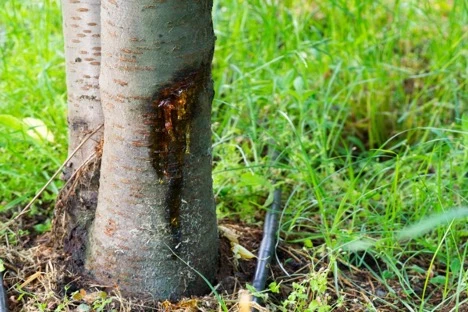Trees are majestic additions to any property, providing shade, beauty, and a habitat for wildlife. However, like all living organisms, trees can face health challenges that, if left unaddressed, can lead to their decline and eventual death. Understanding the symptoms of dying trees is essential for proactive care and intervention.
At Rick’s Certified Arborists, saving trees has been the cornerstone of our company from the get-go. We offer a canopy of tree care services, including Tree Planting, Soil Injections, Trunk Injections, Deep Root Feedings, Growth Regulations, as well as Insect and Disease Control. Additionally, we provide homeowners like you with the resources and tools they need to preserve their lush landscape. So, let’s dive into the signs of a dead or dying tree so that you can spot them early on and contact us to bring it back to life.
Leaf Discoloration and Drop
The leaves of a tree are often the first indicators of its health status. In a healthy tree, leaves are vibrant, green, and abundant. Conversely, a sick or dying tree may exhibit a range of symptoms through its leaves. Discoloration is a common sign; leaves may turn yellow, brown, or black and may fall prematurely. In some cases, leaves may develop spots, blisters, or other deformities, indicating the presence of disease or pest infestation.
Another critical symptom to watch for is the thinning of foliage. If a tree that once had dense, lush foliage begins to show sparse, thin leaves, this could indicate a problem. Additionally, if you notice that new growth is stunted or absent, it could be a sign that the tree is dying. These symptoms often suggest issues with the tree’s internal nutrient and water transport systems, which are vital for its survival.
Bark and Trunk: The Tree’s Outer Defense
The tree bark and trunk are crucial in protecting the tree’s internal systems. Healthy trees typically have smooth, unbroken bark. However, when a tree is dying, the bark can tell a different story. Peeling bark is a significant symptom of a dying tree. While some tree species naturally shed bark, excessive peeling or large patches of missing bark can indicate underlying health issues.
Cracks and splits in the tree trunk are also concerning. These can be signs of internal decay or structural weakness. If the tree trunk shows deep cracks, it may indicate that the tree’s internal support system is failing, making the tree more susceptible to falling over. This is especially dangerous for large trees, as a leaning tree with a cracked trunk poses a significant risk to nearby structures and individuals.
Soil and Root Health
The health of the soil and tree roots is fundamental to the overall well-being of a tree. Poor soil conditions, such as compaction, poor drainage, or lack of nutrients, can lead to a sick tree. Healthy trees require well-aerated soil that allows roots to access oxygen and nutrients. If the soil around your tree is compacted or waterlogged, the tree roots may not be able to function correctly, leading to symptoms of distress.
Tree roots are often hidden from view, making it challenging to assess their health directly. However, symptoms such as visible roots at the soil surface, root rot, or fungal growth around the base of the tree can indicate problems. A dying or dead tree often has compromised roots that cannot effectively anchor the tree or provide it with essential nutrients and water.
Disease and Pest Infestation
Various diseases and pests can affect trees, leading to their decline. Fungal infections, such as root rot and canker diseases, are common culprits. These infections often start at the roots or trunk and can spread rapidly, causing significant damage. Symptoms of fungal infections include mushroom-like growths around the base of the tree, black or discolored patches on the bark, and a general decline in tree vigor.
Pest infestations are another significant threat to tree health. Insects such as borers, aphids, and caterpillars can cause extensive damage to a tree. Signs of pest infestation include holes in the bark, sawdust-like frass, and chewed leaves. Severe infestations can weaken a tree, making it more susceptible to disease and environmental stressors.
Structural Symptoms and Physical Damage
Physical damage to a tree, such as from storms, construction, or other environmental factors, can lead to symptoms indicating a dying tree. Broken branches, damaged roots, and trunk injuries can all compromise a tree’s health. If a tree has sustained significant physical damage, it may struggle to heal and become more susceptible to diseases and pests.
A leaning tree is often a sign of root or structural problems. While some trees naturally grow at an angle, a sudden lean can indicate that the tree’s root system has been compromised, possibly due to root rot or soil instability. If you notice a tree leaning more than usual, it is essential to assess its root health and overall stability.
Professional Assessment and Intervention
If you suspect that your tree is dying, it is crucial to seek professional help. Arborists, like those at Rick’s Certified Arborists, are trained to diagnose and treat tree health issues. They can conduct a thorough assessment of your tree, identifying the underlying causes of the symptoms and recommending appropriate interventions.
Early intervention can sometimes save a dying tree. Treatments may include soil aeration, fertilization, pest control, and pruning to remove diseased or damaged branches. In severe cases, tree removal may be necessary to prevent potential hazards to people and property.
Dealing With Dead Trees? Speak to a Tree Specialist Today!
In addition to being an eyesore, a dead tree poses significant safety risks to your landscaping and your family. By recognizing the signs of a dying tree such as bare branches, root damage, soil deficiencies, bark falling off, and more you can take action to address the issues and potentially save your tree.
If you suspect your tree may be in need of some TLC, reach out to Rick’s Certified Arborists for comprehensive care.

